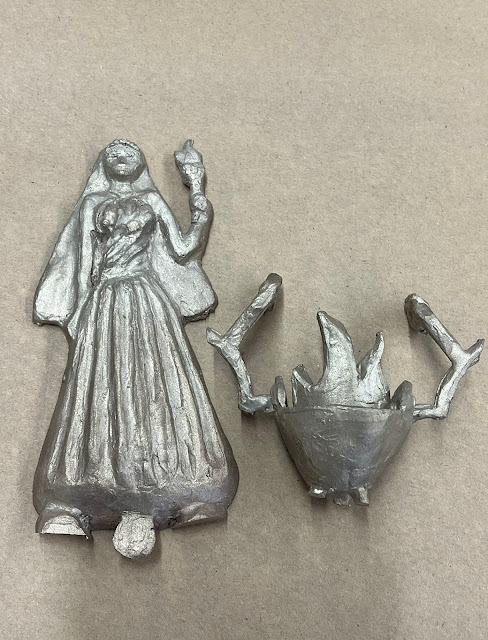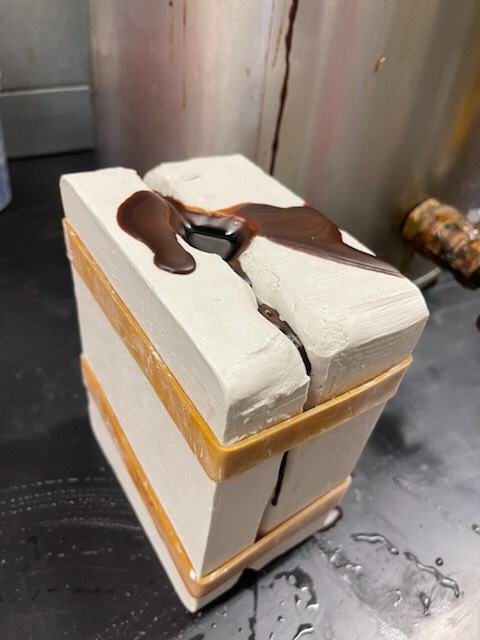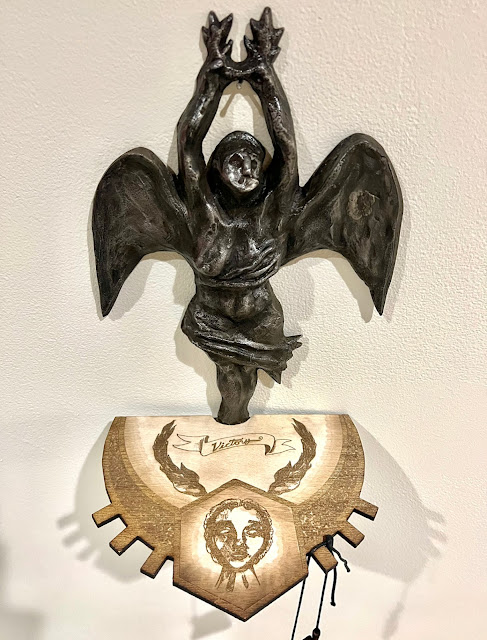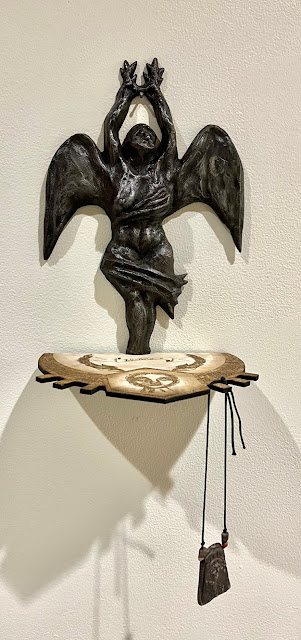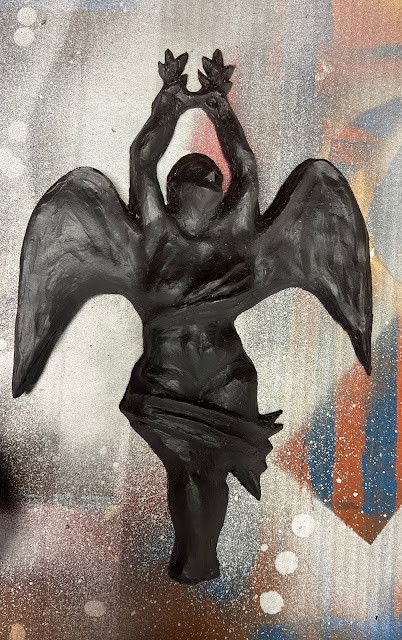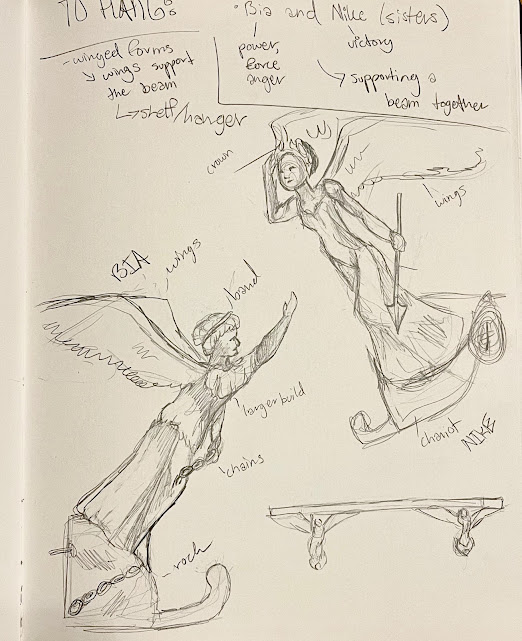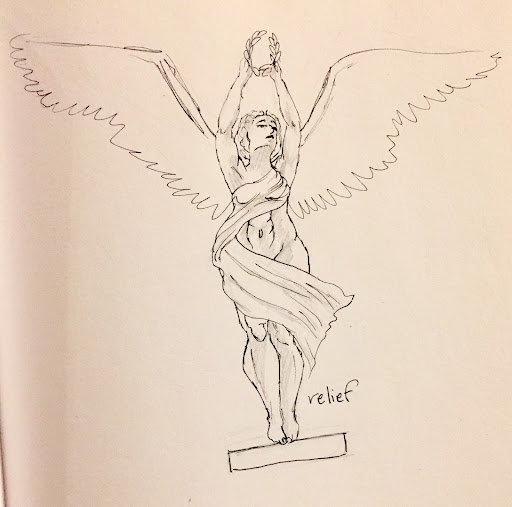UPDATE TO PULL:
Here is the finished "To Pull" with patinated bronze. It is a door knocker.
Here is the application of the patina to the bronze and polishing process:
Here is the bronze after cutting away and grinding the casting:
Here is the bronze after cutting and bending away the sprues:Here was the wax:
Here was the plaster mold with wax:
Here was the clay with vents/parted:
Here was the initial sculpted clay form based on the sketches and concepts below:

In-class and homework SKETCHES for pull:
Images of art and culture inspiring/for ideating:
For my overall theme, I have chosen to focus upon the rich mythology and background surrounding Greek goddesses, their positions, their domains, and the style for inspiration.
Idea #1: Hestia Door Knocker
For my first idea, I have chosen the object of a door knocker (which you pull to create a knocking noise). My inspiration for design was the Greek goddess and Olympian, Hestia. Hestia is known for being the goddess of home, hearth, family, and state (with her often having the first and last libation of the day). In almost every home, she was given a miniature altar space and practiced often daily, as her duties included protection of home/family and domestic life. One of Hestia’s largest symbols is a fire; indeed, if her sacred fire ever went out, it served as a grim portend for issues to come in either home (on a smaller scale) or state (on a larger scale). As she was associated with symbols of fire, stoves, and hearths, I have included fire in her design as well as fashioning the knocker position into the shape of large pot or cauldron. Similarly, in order to keep the theme as well as stay true to her story/character, I have sketched her in a way that is modest and fully covered. In her story, Hestia is a virgin goddess who never married (despite being associated with housewife duties). I have adorned her a veil and modest clothing inspired by ancient statues of her. Her choice as a symbol for the door knocker makes sense, as the door serves as an entrance into the home, inviting visitors in. Nothing pertains more to domestic life, hospitality, and home more than utilizing the mythos of a deity intrinsically tied to matters of the home.
Idea #2: Aphrodite Hairbrush
For my second idea, I continued the theme of Greek goddesses and their ties into everyday objects. In this example, my sketch shows that I have chosen a bronze hairbrush as the next object for pull. Rather than Hestia, goddess of home and hearth, the hairbrush is themed around another Greek goddess and Olympian, Aphrodite. A little more well-known than the former goddess, Aphrodite relates to concepts of love, romance, self-love, beauty, pleasure, fertility, and sexual intercourse. Her symbols are often associated with things surrounding love: swans, roses, and doves. Her origin story relays her coming out of the sea foam and is often depicted/associated with various shells as symbols of the ocean. I incorporated multiple of her symbols in my sketch for a hairbrush (which is used to be beautiful) including a rose, a swan, and sea shells. For her form, I have her wearing very little in order to show off her fertility and sensual beauty.
Idea #3: Lampetia Ceiling Light/Fan pull
In my final sketch idea for pull, I have once more continued the goddess theme, but this time it is with the Greek goddess, Lampetia. For this design, it is a light/ceiling pull chain design. I tried to imbue each option with a different theme/goddess as well as a different object in order to have expansion options. Lampetia is debated on whether or not she is interpreted as a goddess or personification of light. In the particular tale my scene references (as shown with the depictions of a sheep and a cow), Lampetia and her sister Phaethusa are in charge of tending their father's ageless cattle. However, Odysseus's men do slaughter some, which elicits the threat of bringing sunlight into the darkness of the Underworld if punishment were not doled out. The conceptual basis is that pulling on the light pull would bring the (artificial) sunlight into the space and illuminate around.
Edit: (unfortunately I deleted some of the photos I took of the in progress by accident instead of sending them. The mold process is mainly gone, and I will upload both photos of the mold once I am back in the studio next. Here are the remaining:)
TO HANG
UPDATE:
Here is the finished iron, which hangs necklaces:
Here is the drawing I created for the laser cut wood shelf:
Here is the iron bead blasted about to be cut and sanded:
Here is the iron cut from the vents of the pour:
Here is the iron directly after being poured:

Here is the cleaned and primed wax, which went into a sand mold:Here is the initial clay sculpting of Nike:
For my "to hang" piece, I have three different ideas (or variations on designs), which I am considering. As with the prior assignment (to pull), I will be continuing on the conceptual basis of Greek goddesses and daimons for the theme and taking elements from each in order to best represent their themes, domains, and stories.
Artists:
My first artist is Spanish sculptor (known for his metal work and iron sculptures as seen above), Julio Gonzalez. I adore how he has abstracted the forms but still left enough of the torso, face, and body for recognition upon viewing. His balance between detail and generalizing the shape/form is inspiring for my ideas/work.
Tomohiro Inaba
My second artist from the powerpoint that I researched additionally was Tomohiro Inaba, a much more contemporary artist than the former. I enjoy his choices to create pieces which have parts which seem to dissolve or have parts left out/up to the viewer to fill in. The mixture between line and larger sheets of metal has a beautiful balance, which I would love to bring into this assignment somehow.
For my ideas, we first start off with a shelf and coat hanger combination, where there are two metal cast hooks which are shaped after the greek goddess/daimon (depending upon the mythology), Philotes. Known as the goddess of friendship, affection, and in later iterations, sex, Philotes is a lesser known deity. She is the daughter of Nyx, goddess of the night, and sister to numerous gods. Philotes is from the second generation of the primordial pantheon and has ties to the creation myths surrounding humanity. As a whole, I enjoy her and her themes, as friendship and affection. is something which inspires me. In the sketch below, she is depicted less clothed, as she is often associated with sexual intercourse (alongside Aphrodite) and with a pair of wings (as all her siblings have as well). The plate she stands against is in the shape of a heart to mimic the theme of affection. A board rests on the two castings of her, creating a shelf while the cast form contains a hanger to hold coats upon.

My second idea does not stray far from the first. This example uses the same conceptual basis as the former, as Philotes is once again the theme of this sketch. Rather than its purpose being to hang something from it, this example instead is the object being hung. Akin to a form of mobile, this sketch revolves around a cast form of Philotes in the center and plexiglass wings which are connected and strung to a bar above. When pulled, she bobs up and down, mimicking flight.

Finally, we have another version of the first idea: a shelf and coat hanger combination, but with a different conceptual basis. Rather than Philotes twice, this version shows two different goddesses. The two goddesses are sisters (daughters of Styx--goddess of hatred--and Pallas--god of warcraft). Bia is the first example and is the goddess of power, force, and anger. In the myth she is most known for, she was the only god/goddess strong enough to hold Prometheus down with a rock and chain (hence the elements within her design). The other goddess is Nike, who is associated with victory (and now dismal footwear corporation). She is often depicted with a wreath/palm frond on her head, a weapon, and in a chariot. I have implemented all of these aspects within her design. Both goddesses are known to have wings. I thought this example was conceptually strong, as the goddesses of power/strength and victory are holding up this board on their wings.
Final Idea:
TO LIGHT
UPDATE:
Here is my final to light (based on Selene) made of paper casting, polymer clay, steel, and other materials:
Here is the initial sketch for this:
For my "to light" piece, I have several ideas, although none that I feel are entirely fleshed out yet. Once more, as the ideation for my pieces is going to be a common theme, I have chosen various examples from greek mythology as I continue the conceptual basis of Greek goddesses/daimons. This time, I have selected goddesses which pertain to some form of light.
Artists:
Alberto Giacometti
For the first artist that I researched additionally outside of class, I chose Alberto Giacometti. Although he is well-known and often over used in art classes/spaces as an example, I do love his texture and length/weight that he brings to his metal sculptures. He balances the heavier/weighed parts with thinner pieces of metal, while the texture throughout brings a unity to each piece. I found his work surrounding people/busts especially helpful for my ideation for to light.
Frank Plant:
For the next artist, I chose Frank Plant. More recent in time than the previous example, his work expertly mixes linear elements with flat pieces of steel/iron to create a cohesive whole. The first picture of his work really stood out to me, as the finish pushes the material away from steal into a more colorful, vibrant medium (almost akin to layered paper at a larger scale).
Additional Artist, Luis Jimenez:
Although this is a familiar/silly example, I thought of this sculpture first when considering pieces which incorporated light into the end sculpture piece. The bright color choice of red contrasts with blue and gold of the form, yielding an iconic figure. For my ideas, we first start off with a rendition which focuses upon Theia, the goddess of light and eyesight. An important figure in Greek mythos, Theia was a titan and known for her ether, a bright blinding blue light. In mythology, she is responsible for our eyesight, the shine of precious metals and anything that glimmers, and of light within the world. According to one of the biggest myths, her eyes emit a beam of light which allows us (humanity) to see all around us. For the piece, I would create a cast bust (unsure of material currently, but potentially metal finish as it pertains to the tale) in which light comes out from her eyes (paying homage to her myth).
For the final project on my to light, I chose Selene, who is the goddess of the moon. She is actually the daughter of the first example, Theia, and Hyperion. She is the sister goddess alongside the sun (Helios) and the dawn (Eos). She is known for riding her moon chariot across the sky (as the moon revolves through the night). I was interested in her because her name both means gleam and light, and moonlight is another form of light (in nature). For the sketch concept, I envisioned a moon sort of casting (perhaps a paper or other similar material, which would allow light through it). It would be molded and shaped in a way which mimics the moon's light and shadows. In addition, I would have a hanging element which contained her form and another smaller present moon in a golden color to match the lamp base I found.
Steel Photographs (except I went on an adventure and there are a bunch of cast and joined examples):







